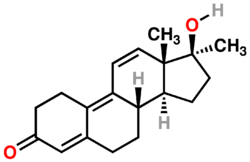Metribolone
 | |
 | |
| Clinical data | |
|---|---|
| Routes of administration | Oral |
| Identifiers | |
| |
| Synonyms | Methyltrienolone, 17α-Methyltrenbolone; R-1881; RU-1881; NSC-92858; 17α-Methyl-19-nor-Δ9,11-testosterone; 17α-Methylestra-4,9,11-trien-17β-ol-3-one |
| CAS Number |
965-93-5 |
| PubChem (CID) | 261000 |
| IUPHAR/BPS | 2857 |
| ChemSpider |
229099 |
| UNII |
2C323EGI97 |
| KEGG |
C14257 |
| ChEBI |
CHEBI:379896 |
| ChEMBL |
CHEMBL166444 |
| Chemical and physical data | |
| Formula | C19H24O2 |
| Molar mass | 284.393 g/mol |
| 3D model (Jmol) | Interactive image |
| |
| |
| | |
Metribolone (INN) (developmental code names R-1881 (or RU-1881), NSC-92858), also known as methyltrienolone (or 17α-methyltrenbolone), as well as 17α-methyl-19-nor-Δ9,11-testosterone or 17α-methyl-19-norandrosta-4,9,11-triene-17β-ol-3-one, is a highly potent, orally active, non-aromatizable anabolic-androgenic steroid (AAS)[1] of the 19-nortestosterone and 17α-alkylated groups which was never marketed for clinical use but has been used in scientific research as a photoaffinity label for the androgen receptor (AR) and in AR ligand binding assays.[2] It is the 17α-methylated derivative of trenbolone (trienolone), and is a similarly potent AAS, but has a high potential for hepatotoxicity similarly to other 17α-alkylated AAS.[3] Metribolone binds with high affinity not only to the AR but also to the progesterone receptor (PR), and binds to the glucocorticoid receptor (GR) as well.[4][5] It is said to be the most potent AAS.[6]
Eleven members of the Greek national weightlifting team and 4 Greek track and field athletes tested positive with methyltrienolone prior to the 2008 Beijing Olympic Games.[7]
See also
References
- ↑ Bojar H, Maar K, Staib W (1980). "The endocrine background of human renal cell carcinoma. V. Binding of the highly potent androgen methyltrienolone (R 1881) by tumour cytosol". Urologia Internationalis. 35 (2): 154–60. doi:10.1159/000280315. PMID 6966435.
- ↑ Brinkmann AO, Kuiper GG, de Boer W, Mulder E, Bolt J, van Steenbrugge GJ, van der Molen HJ (January 1986). "Characterization of androgen receptors after photoaffinity labelling with [3H]methyltrienolone (R1881)". Journal of Steroid Biochemistry. 24 (1): 245–9. doi:10.1016/0022-4731(86)90058-0. PMID 2422446.
- ↑ Krüskemper HL, Noell G (July 1966). "Liver toxicity of a new anabolic agent: methyltrienolone (17-alpha-methyl-4,9,11-estratriene-17 beta-ol-3-one)". Steroids. 8 (1): 13–24. doi:10.1016/0039-128x(66)90114-0. PMID 5955468.
- ↑ Singh SM, Gauthier S, Labrie F (February 2000). "Androgen receptor antagonists (antiandrogens): structure-activity relationships". Current Medicinal Chemistry. 7 (2): 211–47. doi:10.2174/0929867003375371. PMID 10637363.
- ↑ Ho-Kim MA, Tremblay RR, Dubé JY (November 1981). "Binding of methyltrienolone to glucocorticoid receptors in rat muscle cytosol". Endocrinology. 109 (5): 1418–23. doi:10.1210/endo-109-5-1418. PMID 6975208.
- ↑ Schneider G, Kiss A, Mernyák E, Benke Z, Wölfling J, Frank É, Bózsity N, Gyovai A, Minorics R, Zupkó I (2016). "Stereocontrolled synthesis of the four 16-hydroxymethyl-19-nortestosterone isomers and their antiproliferative activities". Steroids. 105: 113–20. doi:10.1016/j.steroids.2015.12.003. PMID 26686898.
- ↑ "Eleven Greek weightlifters test positive; coach suspended". Associated Press / USATODAY.com. 2008-04-04. Retrieved 2009-06-28.
External links
- Metribolone at the US National Library of Medicine Medical Subject Headings (MeSH)